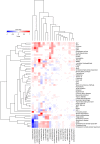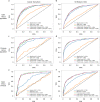Multiomics study of nonalcoholic fatty liver disease
- PMID: 36280732
- PMCID: PMC9649432
- DOI: 10.1038/s41588-022-01199-5
Multiomics study of nonalcoholic fatty liver disease
Abstract
Nonalcoholic fatty liver (NAFL) and its sequelae are growing health problems. We performed a genome-wide association study of NAFL, cirrhosis and hepatocellular carcinoma, and integrated the findings with expression and proteomic data. For NAFL, we utilized 9,491 clinical cases and proton density fat fraction extracted from 36,116 liver magnetic resonance images. We identified 18 sequence variants associated with NAFL and 4 with cirrhosis, and found rare, protective, predicted loss-of-function variants in MTARC1 and GPAM, underscoring them as potential drug targets. We leveraged messenger RNA expression, splicing and predicted coding effects to identify 16 putative causal genes, of which many are implicated in lipid metabolism. We analyzed levels of 4,907 plasma proteins in 35,559 Icelanders and 1,459 proteins in 47,151 UK Biobank participants, identifying multiple proteins involved in disease pathogenesis. We show that proteomics can discriminate between NAFL and cirrhosis. The present study provides insights into the development of noninvasive evaluation of NAFL and new therapeutic options.
© 2022. The Author(s).
Conflict of interest statement
The authors affiliated with deCODE genetics/Amgen, Inc. are employed by the company. The remaining authors declare no competing interests.
Figures





References
-
- Younossi ZM, et al. Global epidemiology of nonalcoholic fatty liver disease-meta-analytic assessment of prevalence, incidence, and outcomes. Hepatology. 2016;64:73–84. - PubMed
-
- Blond E, et al. EASL-EASD-EASO clinical practice guidelines for the management of non-alcoholic fatty liver disease in severely obese people: do they lead to over-referral? Diabetologia. 2017;60:1218–1222. - PubMed
-
- Chalasani N, et al. The diagnosis and management of nonalcoholic fatty liver disease: practice guidance from the American Association for the Study of Liver Diseases. Hepatology. 2018;67:328–357. - PubMed
-
- Adams LA, Sanderson S, Lindor KD, Angulo P. The histological course of nonalcoholic fatty liver disease: a longitudinal study of 103 patients with sequential liver biopsies. J. Hepatol. 2005;42:132–138. - PubMed
-
- Fassio E, Alvarez E, Dominguez N, Landeira G, Longo C. Natural history of nonalcoholic steatohepatitis: a longitudinal study of repeat liver biopsies. Hepatology. 2004;40:820–826. - PubMed
MeSH terms
Grants and funding
LinkOut - more resources
Full Text Sources
Other Literature Sources
Medical

